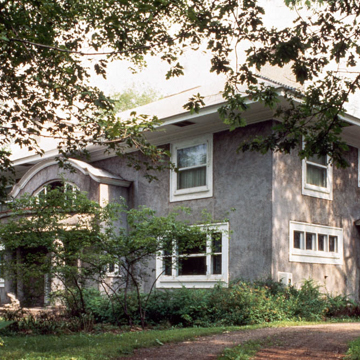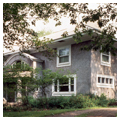Only two doors away from the Ferguson house ( CH15) is another Maher design. Although this home is often referred to by local residents as the work of Frank Lloyd Wright, newspaper accounts of the time identify the architect as Maher, with Marshall N. Hunt as his contractor. According to the Sault Ste. Marie Evening News (May 12, 1906), for an estimated cost of between $10,000 and $12,000, the house would be “one of the handsomest homes in the city.”
Broad projecting eaves, a prominent chimney, and an unusual projecting entrance flanked by two heavy, squat concrete pillars characterize the Prairie School influence in this stuccoed, low-lying house. The unique feature of the entrance is the thin, segmental arch motif with two curious projecting elements near the ends, a theme that is also carried out in the interior. Maher used this unusual feature in two earlier examples in Oak Park and Kenilworth in the suburbs of Chicago.
Maher employed the thistle decorative motif, appropriate for the Scottish origin of Murdock, in the stained glass on the front door, on the capitals of the squat flanking pillars, and throughout the interior decoration. In carrying the thistle theme throughout the house, Maher demonstrated his “motif-rhythm theory” or the “floral element of the locality” theory of design, in which a plant indigenous to the area and/or a specific geometric shape was used as the unifying decorative element.
William Murdock was the treasurer and superintendent of the Northwestern Leather Company, a major company in Sault Ste. Marie that shipped one-third of its production to England. Eventually, Murdock moved back to Boston where the headquarters of the tannery were located, but his home retains evidence of his presence in the freely sculptured concrete dog at the base of the entrance pillar, the dog that once pulled the small Murdock children in their wagons.










